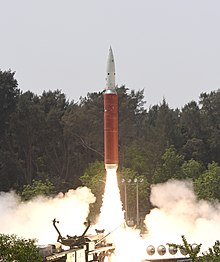| Mission Shakti | |
|---|---|
 The anti-satellite missile lifting off on 27 March 2019 from Abdul Kalam Island as part of Mission Shakti. | |
| Planned by | India |
| Objective | Destruction of target live satellite (suspected Microsat-R) |
| Date | 27 March 2019 11:10 – 11:13 (IST) |
| Executed by | PDV Mk-II anti-ballistic missile |
| Outcome | Satellite destroyed successfully |
On 27 March 2019, India tested an anti-satellite weapon (ASAT) during an operation code named Mission Shakti (IAST: Śakti; lit. "Power").[1][2] The target of the test was a satellite present in a low Earth orbit, which was hit with a kinetic kill vehicle.
The ASAT test utilized a modified anti-ballistic missile interceptor code-named Prithvi Defence Vehicle Mark-II which was developed under Project XSV-1. The test made India the fourth country after the United States, Russia and China to have tested an ASAT weapon.
The test sparked concerns regarding the creation of space debris. The Indian government tried to address these concerns by saying that the debris generated from the test would not last for a long duration.
India's successful demonstration of the ASAT capability is said to signify its ability to intercept an intercontinental ballistic missile (ICBM). The ASAT weapon is meant to act as a deterrent.
- ^ Pubby, Manu (28 March 2019). "India tests first anti-satellite missile system, codenamed Mission Shakti". The Economic Times. Archived from the original on 27 March 2019. Retrieved 4 December 2019.
- ^ Cite error: The named reference
:7was invoked but never defined (see the help page).